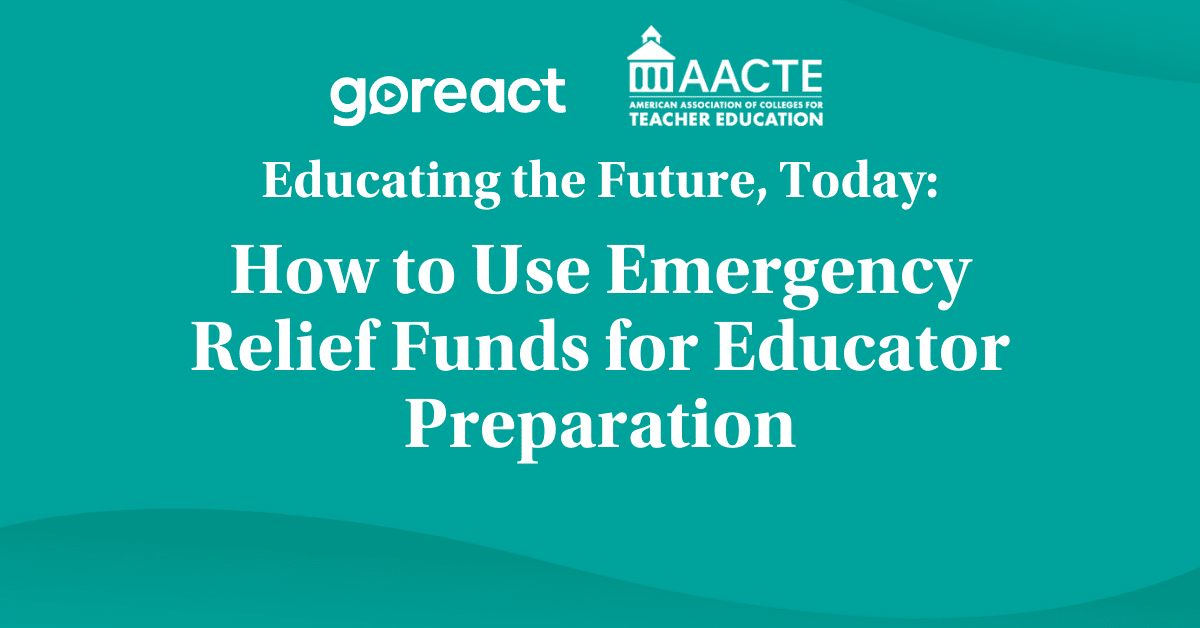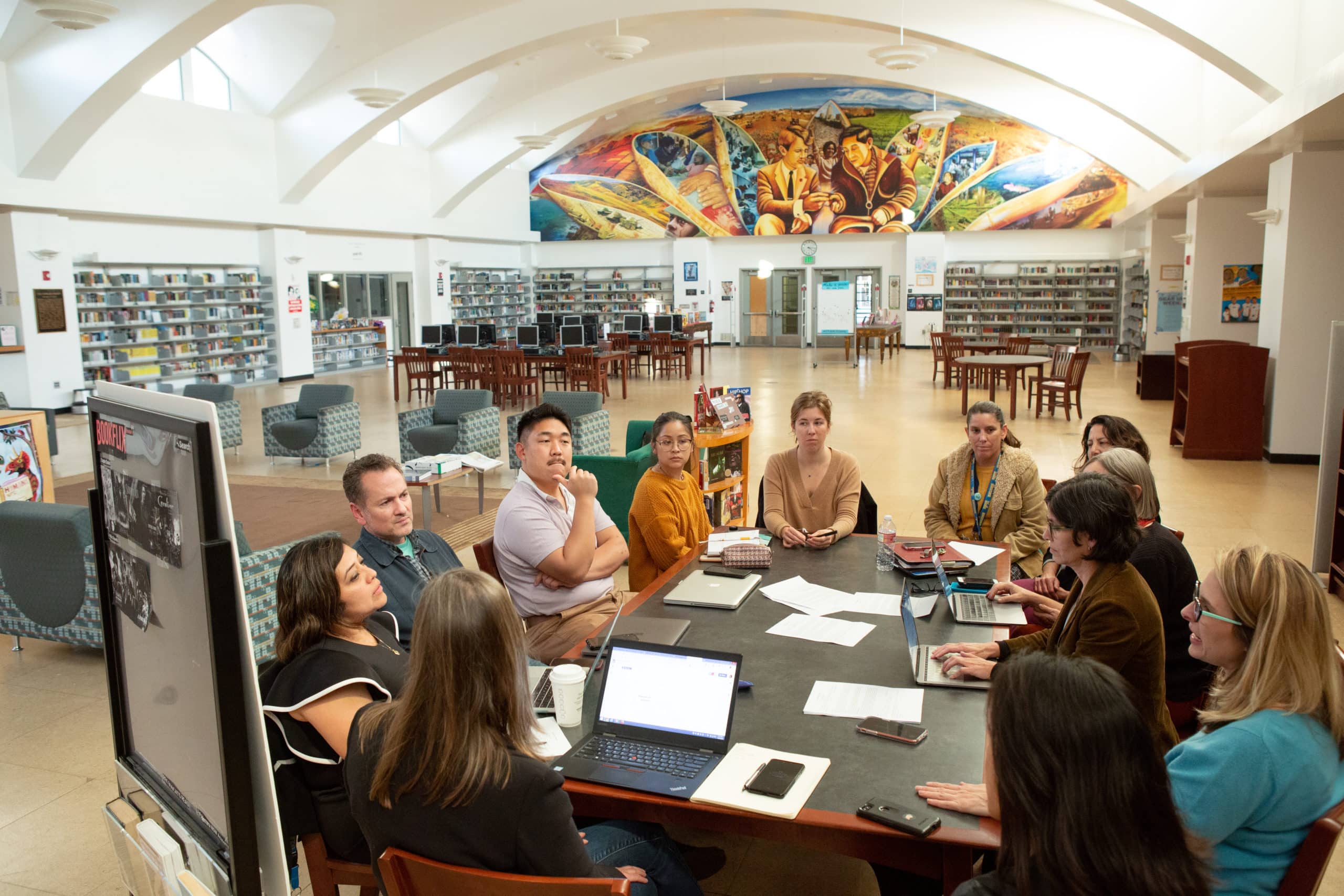30 Aug2021
By Jacqueline Rodriguez
 In the past year, Congress set aside billions for the Elementary and Secondary School Emergency Relief (ESSER) Fund.
In the past year, Congress set aside billions for the Elementary and Secondary School Emergency Relief (ESSER) Fund.
To help educator preparation programs effectively allocate those funds, GoReact and AACTE put together a panel of national, state, and university teacher prep professionals. They’ll dig into one state—Tennessee—that has used ESSER funds to support a statewide Grow Your Own Program to address teacher shortages and diversify the profession.
In this free workshop, our panelists will
- Analyze one particular state’s strategy for ESSER funds
- Share how ALL teacher prep programs can effectively use emergency relief funds
- Provide a resource AACTE has developed to support EPPs and Local Education Agencies to create a pathway into teaching
- Answer participant questions
27 Aug2021
By Lynn M. Gangone
 This article originally appeared in The Hechinger Report.
This article originally appeared in The Hechinger Report.
Long before the pandemic, school districts across the nation struggled to staff classrooms with skilled teachers. The crisis did not create the teacher shortage, but it accelerated teacher retirements and other departures while contributing to declining enrollments in educator preparation programs.
Our nation’s education system spans national, state, district, classroom and community levels. Many rightly wonder if this ecosystem’s demand for qualified teachers can be met in the post-pandemic era.
To do so, we need deeper—and more active—collaborations to address the multiple layers of challenges inside the teaching profession so that we can effectively recruit, train and retain more teachers.
20 Jul2021
By Amaya Garcia and Joseph Hood
 Minnesota is home to an increasingly racially and linguistically diverse student population, yet the diversity of the state’s teacher workforce has remained stagnant. To help address this racial and linguistic match, school districts are partnering with educator preparation programs to develop and implement Grow Your Own programs that seek to recruit and prepare community-based teachers.
Minnesota is home to an increasingly racially and linguistically diverse student population, yet the diversity of the state’s teacher workforce has remained stagnant. To help address this racial and linguistic match, school districts are partnering with educator preparation programs to develop and implement Grow Your Own programs that seek to recruit and prepare community-based teachers.
As outlined in a recent New America report, Minnesota is one of nine states in the country that offers a competitive GYO grant designed to promote teacher residency programs for adult community members and opportunities for high school students to gain exposure to teaching as a career. While the state provides funding, there are few directives about how GYO programs should be designed, reflecting the importance of local control and governance.
20 Jul2021
By AACTE
On behalf of the American Association of Colleges for Teacher Education (AACTE), President and CEO Lynn M. Gangone issued the following statement on the House Appropriations Committee passage of the fiscal year 2022 Labor, Health and Human Services and Education Appropriations bill:
“AACTE is deeply gratified to see such an historic investment in education, and particularly in educator preparation. While our members have advocated for years, indeed decades, for such investments, this is the first time Congress has responded with such a robust bill. These unprecedented increases will make a significant difference in addressing the long-term deficits in our nation’s education system. They will enable our nation to address the critical shortage of educators and the lack of diversity in our profession in transformative ways. AACTE urges Congress to pass this legislation and send it to President Biden for his signature as soon as possible.”
06 Jul2021
By Jacqueline Rodriguez
This article originally appeared in Diverse Issues in Higher Education and is reprinted with permission.
Teacher diversity is invaluable for all students. Having a teacher of color at the helm of a classroom benefits all learners, both academically and through deep and enriching social emotional connections. However, according to The White House’s fact sheet for The American Families Plan, while teachers of color can have a particularly strong impact on students of color, the U.S. Bureau of Labor Statistics reports that only one in five teachers are people of color, compared to more than half of K-12 public school students. That is why President Biden is calling on Congress to invest $9 billion in American teachers, addressing shortages, improving training and supports for teachers, and boosting teacher diversity.
Why teacher diversity matters
Representation in the classroom matters. Having a diverse teacher workforce connects cultures, sets high expectations, and reduces implicit bias. Far too often, students of color feel isolated, underrepresented or mistreated, which leads to lower graduation and higher dropout rates. Decades of research has demonstrated that teachers of color can help close access and opportunity gaps for students of color while being vital to the well-being of students of all races. With a teacher of color leading a classroom, students of color see themselves represented and identify with them as role models. A diverse teacher workforce not only supports a student’s academic and social and emotional outcomes, it can lead classroom students to consider becoming educators themselves.
29 Jun2021
By Jane E. West

“Never let a serious crisis go to waste. And what I mean by that is it’s an opportunity to do things you think you could not do before.” Rahm Emanuel, Former Mayor of Chicago
In the past year, our nation’s educational system faced an epic crisis brought about by the pandemic, leaving education leaders wondering when relief would be in sight. That relief arrived on March 11, 2021, when the American Rescue Plan Act (ARP) was passed by Congress, allocating approximately $130 billion for the K-12 education system and nearly $40 billion for the higher education system. As the Biden-Harris administration launches into action with the massive rollout of unprecedented education funding, school districts now have the financial resources and the opportunity to collaborate with educator preparation programs (EPPs) to tackle a long-standing crisis—the shortage of professionally qualified educators.
14 Jun2021
By Ward Cummings

On behalf of AACTE and the Advisory Council of State Representatives (ACSR), I am happy to announce the winners of the 2020-21 State Chapter Support Award: The three recipients are Nebraska, California and Kentucky.
It is the mission of AACTE to elevate education and educator preparation through high-quality research, professional practice, and advocacy for all learners in ways that are collaborative and that promote diversity, equity, and inclusion. Each year, AACTE awards funding to a handful of projects organized by state chapters in these areas.
08 Jun2021
By Katrina Norfleet
Last month, President Biden called for an unprecedented investment in his FY 22 budget proposal to begin to redress the chronic inequities in our nation’s education system. In a new playbook, the Partnership for the Future of Learning offers a set of high-impact strategies and examples for recruiting, preparing, developing, and retaining high-quality teachers and bringing greater racial, ethnic, and linguistic diversity to the profession.
The 152-page Teaching Profession Playbook was developed by the Learning Policy Institute and the Public Leadership Institute in collaboration with 26 organizations and five individual experts. The digital playbook includes examples of legislation; a curated list of publications, by topic, for further reading; a guide to talking about teacher shortages and strengthening the profession; and examples of research-based policies.
17 May2021
By Makenzie Kenny
This article originally appeared on KOMU 8 and is reprinted with permission.
Education programs across the country were presented with unforeseen challenges during the pandemic, in a career field that is already difficult to recruit for.
Despite these challenges, the University of Missouri’s program has not seen any impact on their enrollment numbers from the pandemic.
A survey conducted by the American Association of Colleges for Teacher Education found that 19% of undergraduate-level and 11% of graduate-level teaching programs saw a significant drop in enrollment this year, according to the New York Times.
Associate Dean for Student Success and Academic Affairs and Professor John Lannin said this is because of intentional outreach to prospective students.
05 May2021
By Mandi Jo John
Exactly two months to the day after President Biden signed the American Rescue Plan Act of 2021 with $125 billion carved out for education, Mursion will host Jacqueline Rodriguez, vice president for research, policy, & advocacy at the American Association of Colleges for Teacher Education (AACTE), for a candid discussion on the challenges and opportunities ahead. From her unique perspective, Rodriguez will share AACTE’s continuing important work for addressing learning loss, critical societal matters that affect education, and the shortage of teachers that has not abated.
30 Apr2021
By Jerrica Thurman

The Tennessee Department of Education is offering Grow Your Own grants to educator preparation programs (EPPs) who work with the state’s school districts. The $2 million grants are available to help remove barriers and increase access to the education field for prospective teachers in Tennessee. The May 7 application deadline is quickly approaching! Application requirements and additional information are available here.
The Grown Your Own initiative supports partnerships between EPPs and Local Education Agencies (LEAs) to provide innovative, no-cost pathways to the teaching profession by increasing EPP enrollment and growing the supply of qualified teachers to serve the state’s diverse student population. It provides no-cost access to a pathway to teaching to meet the need for increased diversity as well as to address the state’s teacher shortage. The second round of grants will provide 20 EPPs with $100,000 for their programs.
23 Apr2021
By Jacob Easley II

The COVID-19 pandemic made a profound impact our nation’s education system. In most states, educational policies have been implemented to promote the wearing of face coverings, physical distancing, virtual instruction, and intermittent school closures based on the rise of positive COVID-19 cases reported in local communities. Despite the many challenges educators face during this unprecedented time, there are lessons learned and a call for transformation that make this the best of times to pursue a teaching career. Here are some reasons why.
19 Apr2021
By David Fuentes and Amy Ginsberg
In the following article, David A. Fuentes and Amy Ginsberg of the College of Education at William Paterson, a member of AACTE’s Network Improvement Community (NIC) Black and Hispanic/Latino Male Teacher Initiative, take a deep dive into their efforts to increase dual enrollment opportunities as a preemptive recruitment strategy. They provide insight into how network improvement science can be used to identify levers within education preparation program systems that can improve recruitment and retention of diverse teacher candidates.
To learn more about NIC members’ initiatives to recruit and retain Black and Latina males, watch the Building Recruitment Pathways, a segment of AACTE’s new NIC video case studies series.
Building and Sustaining Recruitment Pathways for Black and Latino Male Teachers
 In 2014, our College of Education at William Paterson University, a Hispanic Serving Institution (HSI) and Minority Serving Institution (MSI), located in the greater New York City area, was selected as one of ten universities to participate in the AACTE Network Improvement Community (NIC), aimed at increasing the number of Black and Latino/Hispanic male teachers (BLMs). Since that time, we have been engaged in iterative cycles of plan-do-study-act (PDSA). This systematic research first led to our becoming NIC mindful and then to several structural changes in our College of Education that make our efforts aimed at teacher diversification more possible today in both theory and practice. We have uncovered, implemented, and tested the efficacy of several structural changes at our institution targeting key drivers, recruitment and retention, while implementing new structures based on network improvement science and our desire and commitment to diversify our teacher candidate pool.
In 2014, our College of Education at William Paterson University, a Hispanic Serving Institution (HSI) and Minority Serving Institution (MSI), located in the greater New York City area, was selected as one of ten universities to participate in the AACTE Network Improvement Community (NIC), aimed at increasing the number of Black and Latino/Hispanic male teachers (BLMs). Since that time, we have been engaged in iterative cycles of plan-do-study-act (PDSA). This systematic research first led to our becoming NIC mindful and then to several structural changes in our College of Education that make our efforts aimed at teacher diversification more possible today in both theory and practice. We have uncovered, implemented, and tested the efficacy of several structural changes at our institution targeting key drivers, recruitment and retention, while implementing new structures based on network improvement science and our desire and commitment to diversify our teacher candidate pool.
22 Mar2021
By Lynn M. Gangone and Daniel Domenech

Adobe Stock Photos
AACTE President and CEO Lynn M. Gangone and Daniel A. Domenech, executive director of AASA, The School Superintendents Association, authored this article that originally appeared in the District Administration and is reprinted with permission.
 Our nation’s education ecosystem is complex and multifaceted. When one component of the ecosystem is impacted, it creates a ripple effect that is felt throughout the entire system. The onset of the COVID-19 pandemic created a tidal wave of uncertainties, resulting in budget cuts, teacher shortages, and remote learning challenges.
Our nation’s education ecosystem is complex and multifaceted. When one component of the ecosystem is impacted, it creates a ripple effect that is felt throughout the entire system. The onset of the COVID-19 pandemic created a tidal wave of uncertainties, resulting in budget cuts, teacher shortages, and remote learning challenges.
An ongoing concern for school districts, teacher shortages have now become more severe. Teachers are leaving the profession at an accelerated rate, due primarily to health concerns and budget furloughs, and forcing superintendents to close schools not because of infection, but due to a lack of personnel to keep them open. The shortage also expands beyond teachers. It includes bus drivers, cafeteria workers, custodians, and essential support staff. Such reductions, caused by budget cuts resulting from the pandemic, are having a crippling effect upon school districts, and increased operational costs are eroding critical funds necessary to hire the staff desperately needed for in-school instruction.
08 Mar2021
By UTRGV
The University of Texas Rio Grande Valley (UTRGV) is among the top universities to produce the largest number of teachers in Texas, and has among the highest retention rates, according to the 2020 Performance Analysis for Colleges of Education (PACE) study.
The study’s results are from research generated at the University of Houston’s Center for Research, Evaluation, & Advancement of Teacher Education (CREATE).
“Retention of novice teachers in the profession is a very important measure of success for teacher preparation programs given the huge numbers of teachers that leave the profession every year contributing to the tremendous teacher shortage in the state,” said Alma Rodriguez, dean of the UTRGV College of Education and P-16 Integration.
The PACE report also shows that graduates from the UTRGV teacher preparation program have a 91%, 5-year retention rate in the teaching profession. The rate was calculated through a five-year study (from 2015 to 2019) of first-year teachers who graduated from the different educator preparation programs in the state of Texas.
 In the past year, Congress set aside billions for the Elementary and Secondary School Emergency Relief (ESSER) Fund.
In the past year, Congress set aside billions for the Elementary and Secondary School Emergency Relief (ESSER) Fund.






 This article originally appeared in
This article originally appeared in  Minnesota is home to an increasingly racially and linguistically diverse student population, yet the diversity of the state’s teacher workforce has
Minnesota is home to an increasingly racially and linguistically diverse student population, yet the diversity of the state’s teacher workforce has 





 Our nation’s education ecosystem is complex and multifaceted. When one component of the ecosystem is impacted, it creates a ripple effect that is felt throughout the entire system. The onset of the COVID-19 pandemic created a tidal wave of uncertainties, resulting in budget cuts, teacher shortages, and remote learning challenges.
Our nation’s education ecosystem is complex and multifaceted. When one component of the ecosystem is impacted, it creates a ripple effect that is felt throughout the entire system. The onset of the COVID-19 pandemic created a tidal wave of uncertainties, resulting in budget cuts, teacher shortages, and remote learning challenges.